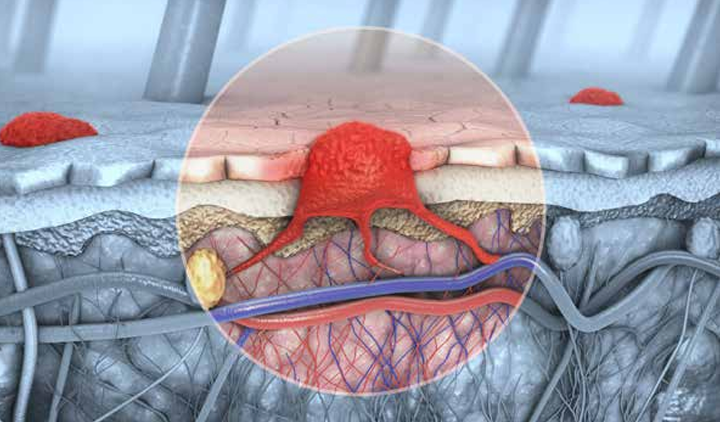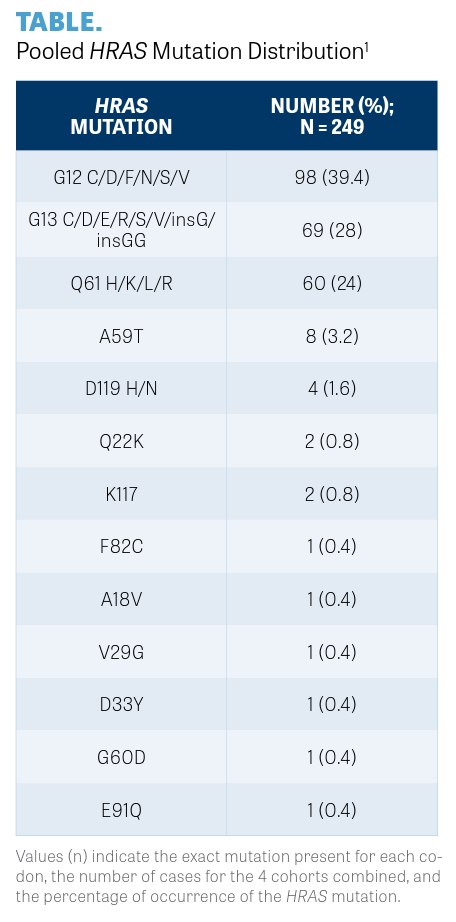HRAS-Mutant HNSCC Delineated in 4 Data Sets
An analysis of 4 deidentified data sets revealed that HRAS mutations occurred in 3% to 4% of patients with head and neck squamous cell carcinoma.

An analysis of 4 deidentified data sets revealed that HRAS mutations occurred in 3% to 4% of patients with head and neck squamous cell carcinoma (HNSCC), with G12S being the most common, appearing in 29% of all point mutations.1 The investigators sought to better define this population by describing HRAS mutational variants, comutation profile, and survival outcomes.
Robert L. Ferris, MD, PhD
Director
Hillman Cancer Center
University of Pittsburgh Medical Center
Pittsburgh, PA

“One of the characteristics of head and neck squamous cell carcinoma that has stymied clinicians is that the disease doesn’t have as many oncogenes as other cancers,” Robert L. Ferris, MD, PhD, endowed professor and vice-chair, Departments of Otolaryngology, of Immunology, and of Radiation Oncology and chief, Division of Head and Neck Surgery at the University of Pittsburgh Medical Center in Pennsylvania, said in an interview. Ferris, who was not involved in the study, is also co–editor in chief of Targeted Therapies in Oncology.
The data were collected from The University of Texas MD Anderson Cancer Center (MDACC); participants from the Kura Oncology KO-TIP-001 trial (NCT02383927); Foundation Medicine, Inc (FMI)-profiled cases; and American Association for Cancer Research (AACR) Project GENIE v12.0.
A total of 249 patients with HRAS-mutant HNSCC were identified across the data sets. The median age ranged from 55 to 65 years, and most patients were male (64%).
The majority of HRAS-mutant HNSCC occurred in patients who were negative for the human papillomavirus (HPV; 78.5%), and HRAS-mutant HNSCC appears to enrich for HPV-negative disease. The rate of tumor mutational burden high was less frequent in the HRAS-mutant population (20.7%) compared with the HRAS wild-type group (27.7%; P = .044).
Regarding the comutational landscape, investigators noted that the functional sites of HRAS-mutant disease were similar across all 4 data sets.
They reported that alterations in codons 12 and 13 accounted for 59% of mutations in the MDACC data set, 70% in the Kura data set, and 68% in the FMI data set. The AACR data set served as a validation set in which the researchers analyzed 153,834 samples involving 137,401 patients.
HRAS mutations made up 3.3% (56 of 1708) of the population, and functional sites for HRAS-mutant HNSCC were similar to those of the 3 other sets. Specifically, alterations for codons 12 and 13 made up 64% of functional alterations (TABLE1), according to researchers.
Comutational Landscape
Regarding the co-mutational landscape, the investigators focused on the FMI data set because it had the largest genomic data set identified. In comparison with HRAS wildtype HNSCC tumors, mutations in CASP8, TERT, and NOTCH1 were the most frequent co- occurring mutations in HRAS-mutant HNSCC tumors, observed in 27% (P < .00013), 60% (P < .00013), and 30.5% of these tumors, respectively (P < .0085). Mutations in CDKN2A were frequently observed in patients with HRAS-mutant disease and those with HRAS wild-type disease (53% vs 41%, respectively, P < .009), in addition to TP53 mutations in both groups (50% v 64%, P < .002).
The investigators noted that 15% of patients in the MDACC set and 19% in the Kura set had no documented co-occurring alterations. The most frequent co-occurring alteration across all data sets was TP53—46% in MDACC, 32% in Kura, and 53% in FMI.
Tipifarnib
HRAS-mutant tumors have been found to be susceptible to inhibition of farnesyltransferase (FTase); thus tipifarnib, an FTase inhibitor, has been evaluated in this population. Clinical research has revealed that treatment with tipifarnib has resulted in an objective response rate of 55% and a median overall survival (OS) of 15.4 months.2 Based on these findings, the FDA has granted the agent breakthrough therapy designation.3
“Developing an inhibitor is an important step in precision medicine for head and neck cancer,” Ferris said.
The investigators determined whether the location of HRAS mutation affected response to tipifarnib therapy by evaluating the Kura data set. In this data set, 20 patients with HRAS-mutant HNSCC with HRAS variant allele frequency of 20% or greater received tipifarnib and had evaluable disease response. Investigators noted that treatment responses were not codon specific, emphasizing partial responses in patients with HRAS-mutant HNSCC in codons 12, 13, 61, and 22.

Clinical responses to tipifarnib were analyzed from the MDACC and Kura data sets. The majority of patients had stage IV disease, with 63% in the MDACC set and 85% in the Kura set. Primary definitive treatment was surgery followed by adjuvant or up-front concurrent chemoradiotherapy in both data sets. Analysis of the MDACC clinical data set confirmed that clinical outcomes in HRAS-mutant HNSCC, overall, were poor, with a high rate of relapse following primary definitive treatment and relatively short disease-free survival (DFS; 4.0 months) and OS (15.0 months).
The DFS was 4.0 months (range, 1-63; 95% CI, 2.0-6.0) and OS was 25.5 months (range, 4-94; 95% CI, 18.0-48.0).
As the largest genomic data set of HRAS-mutant HNSCC reported, the researchers confirmed the occurrence of HRAS mutations at 3% to 4%. HRAS mutations occurred in both HPV-positive and HPV- negative HNSCC, although more frequently in HPV-negative tumors.
The investigators wrote that their “data provide additional insights into this rare genomic subset of HNSCC, which may be of interest in future clinical trial design.”
REFERENCES:
1. Coleman N, Marcelo KL, Hopkins JF, et al.HRASmutations define a distinct subgroup in head and neck squamous cell carcinoma.JCO Precis Oncol. 2023;7:e2200211. doi:10.1200/PO.22.00211
2. Ho AL, Brana I, Haddad R, et al. Tipifarnib in head and neck squamous cell carcinoma with HRAS mutations.J Clin Oncol. 2021;39(17):1856-1864. doi:10.1200/JCO.20.02903
3. Kura Oncology receives FDAbreakthrough therapy designationfor tipifarnib in head and neck squamous cell carcinoma. News release. Kura Oncology. February 24, 2021. AccessedMarch 2, 2023. https://bit.ly/3pRWTtN

Survivorship Care Promotes Evidence-Based Approaches for Quality of Life and Beyond
March 21st 2025Frank J. Penedo, PhD, explains the challenges of survivorship care for patients with cancer and how he implements programs to support patients’ emotional, physical, and practical needs.
Read More